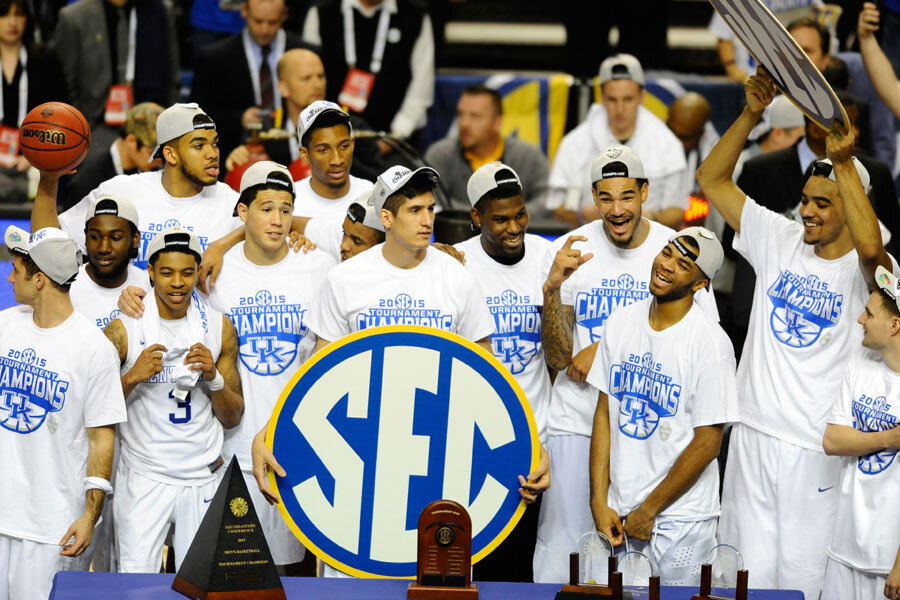Kentucky
Did you know that this year’s team lists three little-used seniors on its roster? Tod Lanter, Sam Malone, and Brian Long all average less than two minutes per game, making them the least used Wildcats. All, however, have earned conference academic honors one or more times.
Kansas
Did you know that basketball inventor James Naismith is the only coach in school history to have a losing record with the Jayhawks, or that in his first game with Kansas, Wilt Chamberlain scored 52 points and grabbed 31 rebounds?
Notre Dame
Did you know that the Irish were named national champions by the former Helms Athletic Foundation of Los Angeles for the 1927 and 1936 seasons, before there was an NCAA tournament, or that Notre Dame has only reached the Final Four once, in 1978?
Maryland
Did you know that Maryland’s former home court, Cole Field House, is reputed to be the site of the most upsets of No. 1-ranked teams, including of Kentucky during the 1966 Final Four by Texas Western (now Texas El Paso)? That game is famous because it marked the first time an all-black starting five (the Miners) took the floor in NCAA championship history?
West Virginia
Did you know that the Jerry West-led Mountaineers were barely edged, 71-70, in the 1959 NCAA championship game by the University of California?
Butler
Did you know that student applications to Butler rose 41 percent after the Bulldogs reached the 2010 Final Four, where it lost to Duke, 61-59?
Wichita State
Did you know that this marks a school-record fourth consecutive season that the Shockers, who began as the Wheatshockers in 1906, have made the NCAA tournament?
Cincinnati
Did you know that with Oscar Robertson, the Bearcats finished third in the NCAA tournament in 1959 and 1960, but they won the championship the next year without the “Big O”?
Purdue
Did you know the Boilermakers have made an impressive return to competitiveness after finishing in the Big Ten cellar and losing the last seven games of their season?
Indiana
Did you know that when the Hoosiers completed their perfect 1975-76 season, the last in major-college basketball, it came the year after they had gone through the previous regular season undefeated, but lost in the tournament to Kentucky?
Texas
Did you know that when Kevin Durant of Texas was the 2007 national Player of the Year, the Longhorns only got to the second round of the NCAA tournament?
Buffalo
Did you know that former Duke point guard Bobby Hurley, in his second year as head coach, has taken the Bulls to the Big Dance for the first time? Hurley is best remembered for leading Duke to the Final Four three times, including during consecutive national championship seasons in 1991 and 1992.
Valparaiso
Did you know that Homer Drew or one of his two sons, Scott (now the Baylor head coach) or Bryce, has coached the Crusaders ever since 1988, with Homer coming out of retirement from 2003 to 2011 to keep the family run alive? Or did you know that Valpo was once known as “The World’s Tallest Team” in the 1940s when it had a pair of 6 ft. 10 in. players, and another of 6-9?
Northeastern University
Did you know that Northeastern plays in what is described as the country’s oldest multipurpose athletic building, the 6,000-seat Matthews Arena (the former Boston Arena)? The building, which has undergone a few major renovations since opening in 1910, has seen Jack Dempsey and Joe Louis box there, the Celtics and Bruins play their first games there, and Babe Ruth skate in hockey scrimmages on the arena’s ice rink.
New Mexico State
Did you know that the Aggies had a basketball program in 1904, eight years before New Mexico statehood, and that they reached the Final Four in 1970, when they lost to eventual champion UCLA?
Hampton University
Did you know that Hampton enters the NCAA tournament with a losing 16-17 record, but that the No. 6 seeded Pirates went on a roll by winning the Mid-Eastern Athletic Conference tournament with four straight wins despite playing without leading scorer Dwight Meikle?
Manhattan College
Did you know that the Jaspers (named for Brother Jasper of Mary, who is credited with starting baseball’s seventh-inning-stretch tradition) plays its home games in 2,345-seat Draddy Gymnasium?







